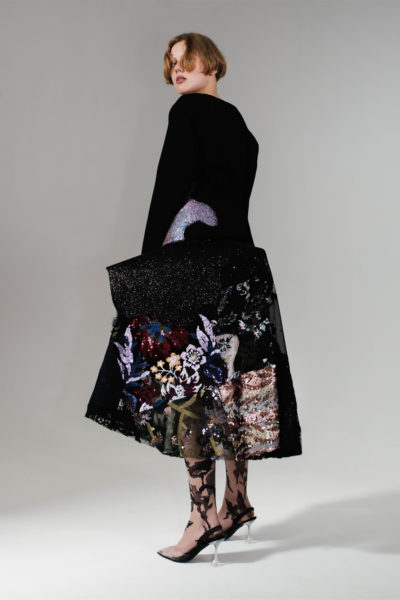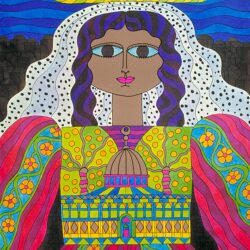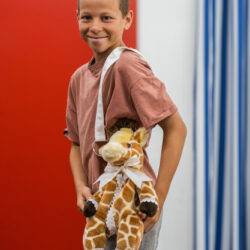And the MoMu Award Goes to... Dominika Grzybek

Every year, MoMu awards an MA fashion graduate from the Antwerp Academy whose work stands out in terms of its graphic quality. This year, two such awards were granted. One was bestowed on Dominika Grzybek for her collection ‘Ikebana’. The title references the Japanese art of flower arrangement which, in Grzybek’s work, becomes part of a personal and political story that interweaves her own childhood memories with threads of feminism. Grzybek tells this story through textiles, and elaborates on it in her visuals, which are on view in the MoMu Café lightboxes this Spring.

Why did you decide to go into fashion in the first place?
DOMINIKA GRZYBEK: “I suppose it came quite naturally to me. My parents are both artists, and I practically grew up in my mother’s studio. One of my first memories is of me sitting on the floor behind her while she is making tapestries, surrounded by pieces of yarn and scraps of fabric. I used to toy with those, her studio was my playground.”
“I had a mind-blowing encounter with fashion when I visited an exhibition of the work of Martin Margiela at Somerset House in 2010 (this exhibition was first mounted at the MoMu in 2009, ed.). I was shocked and deeply moved by Margiela’s work. That is what fashion does: it gets to your emotions. It tells such strong stories, but in a non-obvious way, combining art, movement and performance.”
“I initially studied fine arts in Poland for five years. These five years were beautiful, but somehow afterwards, I wasn’t fulfilled. I wanted to move forward, but I ran into an invisible wall. At a point when I didn’t know what to do with my life, I thought about that Somerset exhibition, and decided to follow that dream. I went to the same academy where some of my favourite designers had studied: Margiela, but also Walter Van Beirendonck. His work is so free, so connected to the feelings of childhood. I like this idea of nursing the small child within yourself.”
Can you tell us more about your graduation collection?
DG: “The starting point for my graduation collection was a celebration which takes place in the middle of August in several Slavic countries, where village women make flower bouquets and carry them to churches. It’s visually very beautiful. I did research on this celebration and learned that it is, in fact, done all over the world in different ways: the making of bouquets and taking them to religious places. I found that it is rooted in an old pagan celebration in gratitude to Mother Earth, for the good things that she serves each year. ”
“What interests me around this celebration is the fact that it is a women’s issue. So is the manipulation of fabric. Embroidery, knitting, weaving: they have been ways for women to voice themselves. Whenever I work with fabric, I reflect on my past and on my relationship with other women, some of them my own ancestors. I connect to them in this way.”


How did you translate these memories and affects into garments?
DG: “The bouquets the women carry are quite large and very textured. I wanted to evoke the feeling they give me through fabric manipulation. I ended up making paintings of the bouquets. Then I took the outlines of the drawings, these became the outlines of my patterns. I constructed the garments by folding the patterns into flower-like shapes: the folds became darts, the small gaps between the petals became armholes or neckholes. This is the graphic part for me: that which is informed by shape, or solid figures.”
“As for the working of the surfaces, I wanted the process to be similar to painting. So I prepared my yarns like I would prepare my paint, cutting different colours of yarns in certain lengths and laying them out. Every day, I would change the way I worked, the colours, the textures, based on my mood or the atmosphere.”
“I named my collection ‘Ikebana’, a word that is related to another childhood memory. My mother once took me to a flower shop with beautiful flower arrangements. ‘Ikebana’, she called them. To me that was a magical word, and it has stayed with me ever since.”
As for the future, what do you want to follow up on?
DG: “The power of clothes and the way they tell stories is insane to me. This is something I would love to keep focusing on. I am very curious to see how fashion companies and houses will reflect all the changes we are seeing right now, whether they are social or when it comes to climate change, for example. What will their next moves be? This is something I want to be a part of.”
Dominika Grzybek’s collection imagery is on display at the MoMu Café from February until September 2023.
Photo: Wiktor Malinowski
Models: Yatsiuk Oleksandra & Laura Meier Hagested
MU & Hair: Jinny Song
Production: Mark Wegner
Retouching: Dorota Kaczmarek
Jewellery: collaboration with Rosalie Carlier
Stockings: collaboration with Fiore femmes









